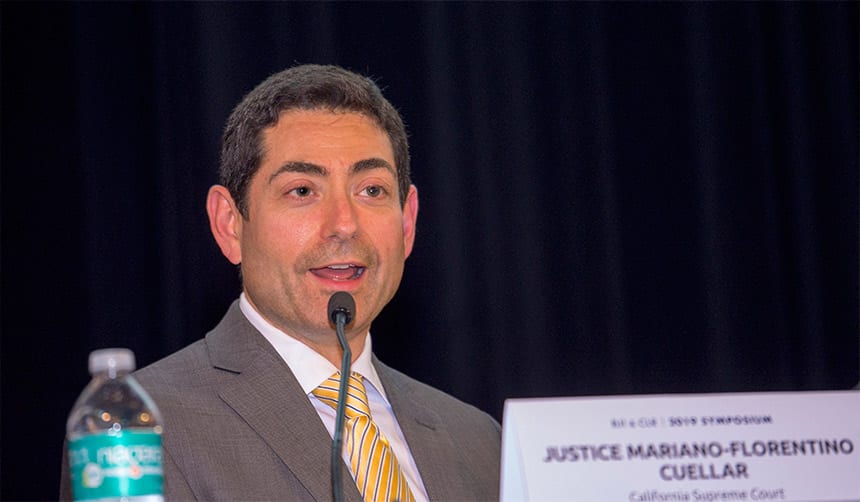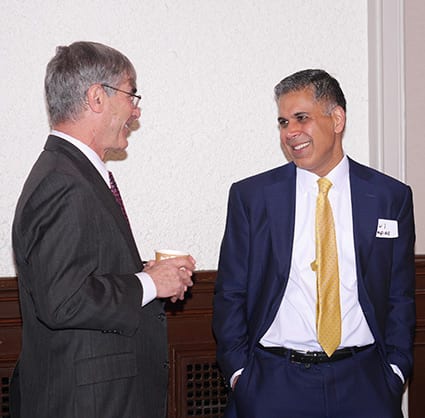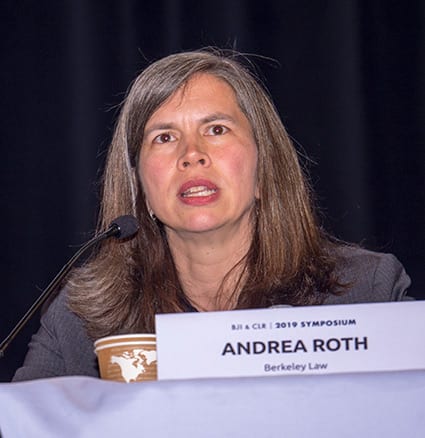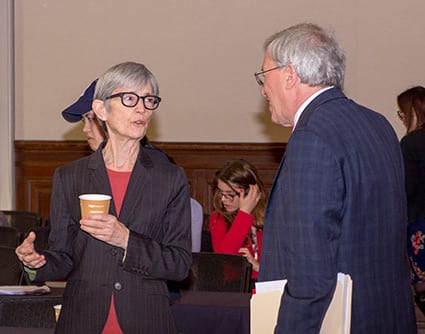
By Andrew Cohen
The Berkeley Judicial Institute aims to address growing challenges faced by the federal judiciary. BJI’s inaugural symposium focused on reviving judiciary reform efforts.
The institute convened an exceptional group of judges, practitioners, and scholars who came from all over the country for its debut event April 12.

“There’s an increased burden on federal courts fueled by rising population, economic growth, technological advance, social change, and expanding federal law,” said Berkeley Law Professor Peter Menell, who organized the symposium with BJI Executive Director Jeremy Fogel. “We’re seeing a continuation of the explosion of federal litigation, and arguments over how to handle this.”
BJI provides education and resources for jurists, helps faculty and students better grasp how the judiciary works, and seeks to make legal scholars more relevant to judges’ daily work. With troubling case bottlenecks, a rising number of circuit splits, and trial complexities flowing from rapid technological advancements, the fragmentation of national law and mounting burden on judges pose dire concerns.
Discussing a paper he is writing with University of New Hampshire Law School Professor Ryan Vacca, Menell noted that cases filed in federal district courts soared from about 140,000 in 1970 to more than 379,000 in 2017. Though more judges were added, the number of cases filed per judge in that period still increased 72 percent.
Panelists conveyed troubling empirical and anecdotal reports of an overtaxed system, and its growing inability to resolve disputes across circuits.
“Looking forward … what would make things more optimal and better serve the realities of the present day?” said Fogel, who spent 37 years as a judge and 7 directing the Federal Judicial Center, the research and education arm of the government’s judicial branch. “This is not a one-off. The goal is to create ideas and then follow up on them.”
The California Law Review will publish papers from the symposium, and BJI expects to release a report summarizing its recommendations.
The event included an academic panel moderated by Berkeley Law Dean Erwin Chemerinsky and a practitioner panel moderated by Professor Amanda Tyler. It also featured two panels moderated by Fogel—one with district court judges and another with appellate court judges, many of whom called for greater flexibility and creativity in sharing resources across circuits and districts.
U.S. Second Circuit Court of Appeals Judge Jon O. Newman—2016 recipient of the Edward J. Devitt Distinguished Service to Justice Award, the highest honor bestowed upon a U.S. Article III federal judge—delivered the keynote address. A federal judge for nearly 50 years, Newman provided a rich account of how the judiciary has weathered the challenges of rising caseloads during his career and offered valuable insights about how to improve the judicial system’s productivity without sacrificing its effectiveness.

The symposium explored myriad challenges, including the difficulties for judges in grasping complex patent cases and a troubling decline in jury trials. Panelists probed ideas to alleviate the litigation bottleneck, such as eliminating diversity jurisdiction, rethinking the Class Action Fairness Act, and creating more geographic flexibility to balance workload disparity in different states.
Criminal law trouble spots
Berkeley Law Professor Andrea Roth described the increased federalization of crime—the U.S. has about 5,000 federal statutory crimes and 300,000 federal criminal regulations. Implications include a massive increase in immigration offenses that has produced caseload overflows in districts along the southern border.
“The number of criminal jury trials has decreased 46 percent since 2001. Our criminal adjudication system is now about pleas, not jury trials,” said Roth, who discussed efforts to eliminate preemptory jury challenges, amend the rules of criminal procedure to allow judges a role in plea negotiations, and allow juries to have advisory roles in sentencing.
Roth also noted how technological advances, such as increasingly sophisticated forms of surveillance that trigger 4th Amendment concerns, are vexing criminal cases. “We’re facing a surge in forms of proof that the Rules of Evidence don’t neatly account for now,” she said.
Others added that two of the four main legal texts used in criminal law—the Federal Criminal Code and the Federal Sentencing Guidelines—need a major overhaul.
Lessons from MDL
Berkeley Law Professor Andrew Bradt, an expert on Multidistrict Litigation, cited the case aggregation tool as “an amazing example of judicial reform now celebrating its 50th anniversary. It’s essentially a nationalization of the federal courts versus a decentralized body acting in different geographic areas.”
MDL now accounts for more than 40 percent of federal cases, often centering on products liability and antitrust disputes.
“It works practically and gets all parties involved in the controversy engaged in the case and working toward a potential settlement,” Bradt said. “The system also doesn’t systemically advantage plaintiffs or defendants and affords flexibility to individual judges to manage cases. MDL is a success story that can offer us a lot of ideas.”

Renowned consumer protection litigator Elizabeth Cabraser ’78 said all her current cases are part of an aggregate dispute—and that the federal system has capably managed such litigation.
“I’m a fan girl of the court system,” she said. “This is the branch that does the most for the people with the least share of government resources. … We need more pay for judges to attract and keep the very high caliber of professionals we currently have in the federal judiciary. They’re grossly underpaid, which means at least indirectly that our society undervalues them, and I think that’s criminal.”
Malini Moorthy, general counsel of Medtronic, a leading medical technology company, raised concerns about the fairness of the MDL process and urged reforms.
Seeing the big picture
Chemerinsky urged participants to consider why we have federal courts. He cited their ability to enforce the Constitution, serve as an umpire for inter-state disputes, provide greater uniformity, create federal common law, and review agency decisions.
Lamenting a study showing that most people could identify more of Snow White’s seven dwarfs than Supreme Court justices, Chemerinsky sees “an enormous responsibility of law schools, judges, and law professors to educate people about what courts and judges do.”
K&L Gates partner Jonathan Cohen ’95 urged more social science research on courts as an institution to guide case management and understand how judicial overload affects court decisions. Studies show a less consistent approach among rulings, a decline in courts’ collegiality, and fewer oral arguments and written opinions.
“The question is how this overload is undercutting the ability of judges to deliver what’s ultimately the product,” Cohen said. “More than justice, it’s also an efficient justice delivery system.”
Paul Grewal, Facebook deputy general counsel and a retired magistrate judge, pointed to variations in the craft of judging “creating uncertainty and inconsistency.” With the increase in multinational corporations, he said the U.S. should promote adjudication consistency not just domestically but in courts worldwide.
While panelists praised the overall quality of federal judges, some called for new ways to deal with the small percentage that are problematic. David Patton, executive director of Federal Defenders of New York, also urged balancing the disparity in judges’ professional backgrounds. In the two districts where he defends clients, he said, “About half of the judges are former prosecutors and only one is a former public defender.”
Renowned Supreme Court advocate Kannon Shanmugam argued that reform is also essential to sustain the public’s confidence.
“The quality of judges is under threat as it’s becoming less attractive to be a federal judge,” said Shanmugam, who chairs the Supreme Court and Appellate Practice Group at Paul, Weiss in the firm’s Washington, D.C. office. “We should want a judgeship to be the highest calling in our profession.”